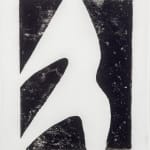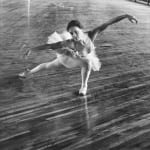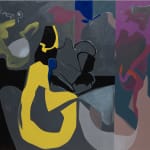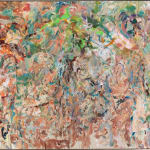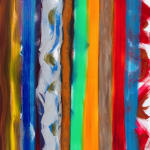Arrayed in two large rooms at Corkin was sixty years of painting by fourteen artists working primarily in Montreal, Paris, New York, and Toronto. The curatorial choices made in Traces of Abstraction suggest that we should not judge the quality of the work on patterns of migration – on who lives where, and immediately when – despite the influence that markedly different cities have had on the artists who live there.
Post-war Modernism for some of the painters in the exhibition was a condition to be forged, and for others, embraced, revised, or complicated within the terms of subjective practice. Although internationalist, most of the works in the exhibition could not have been achieved simply anywhere. It is difficult to think of, for example, the work of Toronto-based, Gina Rorai (b. 1966) having been painted in New York. Her always compelling domestic scenes, occasionally inhabited by jumbles of furtive, forgotten ceramic figurines, natural objects, and small abstract or landscape paintings, stage a sensibility that is unlikely to have issued from the pace, the living spaces, and the ethos of New York.
In Traces of Abstraction, Rorai was represented by a two-metre-high work, Cappa Violet (2015) almost entirely composed of horizontal bands of rich colour. This canvas achieves that rare distinction in abstract painting: the material and the spiritual, genuine and mysterious, in equal measures pervasive. In Cappa Violet, painted while Rorai was thinking of Giotto’s Scrovegni Chapel frescos, the quickly changing things of the natural world, and the slightly more fixed apparitions of memory, lent themselves to their representation as painting.
Cutting across several wide bands was a tall rectangular form like a window: a stack of einnumerable slim landscapes of field and sky. On another day, this window sitting underneath four wide bands that capped the painting – a blue dome, rushes of grey-green performing the movement of clouds, a red that somehow spoke of everything crimson, and a thick, golden turbulence – might seem not to be a window at all but a hanging carpet woven of a flux of landscapes. Perhaps this spoke of one of abstraction’s disciplinary strengths: that the ‘optical’ eye and the mind beneath it are prey to association. The painting that you are intently looking at might become something else, seen palpably for the first time.
Occasionally, something about a painting’s complexity, or its elusiveness, doesn’t allow you to remember it well. We can’t really fault the painting. If it weren’t for the photos in your family album, would it be possible to remember your grandparents’ faces after they are gone? What is most important is the correspondence in the gallery between a particular painting and a viewer engaged in the act of looking at it. Without these circumstances, painting and viewer, self and other, there is not much reason to look. To borrow from Delmore Schwartz’, Seurat’s Sunday Afternoon along the Seine, “Selfhood will possess and be possessed....”
In 1956, looking at three of Monet’s paintings in the New York museums, Leo Steinberg came to understand that “the hierarchy of things more or less real, is not determined by degrees of tangibility; that all those things are real which fully form the contents of experience.”
Steinberg’s Monet was evoked in Traces of Abstraction by the Montreal painter, Jean McEwen (1923-1999). Paysage Inachevé #16 (1989) is a landscape pushed just past the edge of the three-dimensionality allowed modern, post-war abstraction. Within variably loose 2 borders like a painted picture frame in which colour was simply colour, could be found the gentlest of dreamy landscapes. Soft greys becoming mauve are clouds covering a plain before a mountain. Yet, in the substance of its movement, this cloud cover seems also to form the plain and mountain beneath it. Ochres, yellows, reds, and browns are small generative astonishments of colours becoming each other. In places, greys are tipped with white like salve, or blacks like the char of Bizen pottery, dustings of ash that might be a tree line tracing the mountain.
As in most of McEwen’s work, the paint in Paysage Inachevé #16 was applied directly to the canvas with his hands. This painting is successfully less dense, less worked than many of his canvases. Here, to work with the hands, is to touch what is disappearing. A soft, enveloping coolness. In places, a soft sheen. The insistent drift of le désir.
Adrian Stokes noted in his 1957 essay, Monet that “the fragmented brush stroke,” the tache, meant “the essence of all modern painting, a distinction more fundamental than any issuing from degrees of monumentality, naturalism, distortion or abstraction.” This Monet was taken up by Larry Poons (b. 1937). In the upper left corner of Farewell Dollop (2016) is a plum streak on the canvas: a stain of drying berry-red overlaid with a palette knife’s slick of thick shiny paint of the same hue. As if fallen forward from aqua and pale orange, from tufts and stalks, sunlight yellows come to rest in the upper right, constant and brief. Poons’ works are unalterably, materially of the moments of their making, and this fact transfers to the moments of their being looked at.
Perhaps this reflects Poons’ post-war New York understanding of opticality. His paintings are strongly suggestive of landscape, yet everything occurs very clearly on the surface of the picture plane without a hint of chiaroscuro. Poons’ landscapes are landscapes of mark making. On the most complex sunsets, John Ruskin wrote in the first volume of Modern Painters (1843): “Colours that have no words in language, and no ideas in the mind – things which can only be conceived while they are visible.”
It is difficult not to think about the place of music in Poons’ recent work. He brings forward modern painting since impressionism without undue reverence or solemnity, and makes of it something tangibly, vigorously continuing. In music, the movement and play of incorporating something of another, often prior, composer’s work into your own is a plain necessity which somehow Poons’ paintings seem also to do in an evocative flow. His work is certainly not ersatz music, but there is something fundamental about it that seems of music.
Leopold Plotek was born in 1948 in Moscow, raised in Warsaw and studied at the Slade in London. With his early canvases such as Leporello in Disguise (1978) he began to open the flat picture plane used by Montreal abstract painters since the war, like a Renaissance stone cutter opens a building’s interior to light and shadow. In the exhibition, Brun Rouge Ocre Jaune et Vert (1974), a Colour Band series painting by one of Plotek’s mentors, Yves Gaucher (1934-2000), a giant of Montreal abstraction, was a fine demonstration of Montreal surfaces in the 1960s and 1970s – five discrete colours applied to a large canvas without evidence of the painter’s touch.
Plotek’s work of the late 1970s and early 1980s is not without bright colour and, at times, dark humour. He uses the lines and spaces of buildings to construct a unique imagery representative of the human condition. It might be said, after Adrian Stokes (The Stones of Rimini (1934) was an early influence) that Plotek’s art works “steadily on integration of the 3 inner world as an outer image.” Leporello in Disguise, staged in the interior space of an Italian Renaissance building, transmits a strong sense of the figurative via Plotek’s use of drawing – a somewhat unstable, hand-painted line – and shadow. Often, Plotek’s shadows are things that seem to have taken on their own, singular lives. Young painters who see Plotek’s almost fifty-year-old canvases often mistake them for recent works. Perhaps this freshness can, in part, be accounted for because it foreshadows developments in painting in the early twenty-first century.



